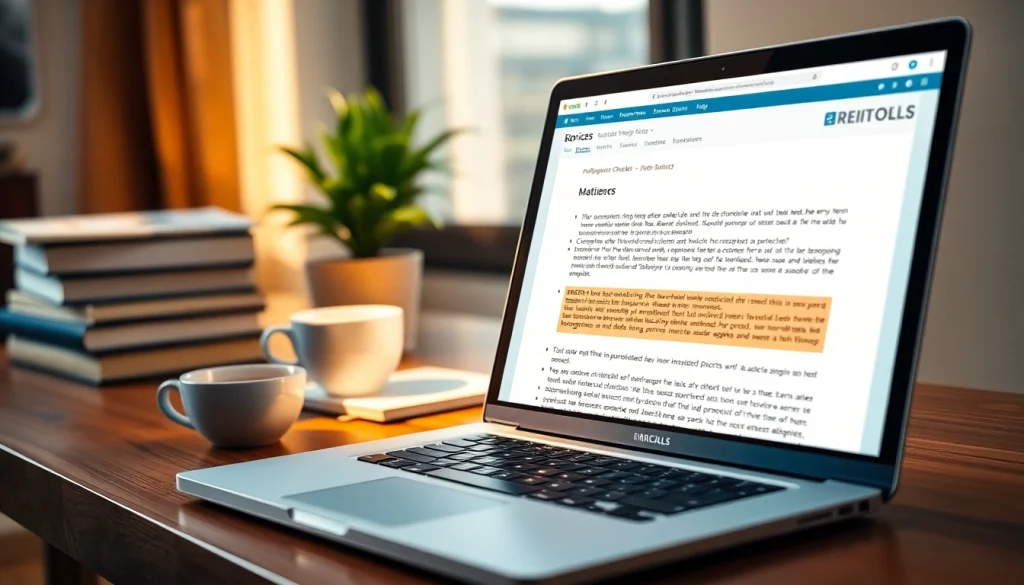
Understanding the Importance of a Plagiarism Checker
In today’s digital age, where content is created and shared at an unprecedented rate, maintaining originality is paramount. Writers, students, researchers, and educators the world over grapple with the challenges of ensuring their work is both credible and authentic. This underscores the significance of utilizing a plagiarism checker to verify the uniqueness of content. Plagiarism checkers serve as essential tools in the arsenal of anyone involved in writing or content creation, as they not only help promote academic integrity but also bolster one’s reputation in the professional landscape.
What is Plagiarism?
Plagiarism is the act of using someone else’s words, ideas, or work without proper attribution. This unethical practice can manifest in many forms, including verbatim copying, paraphrasing without credit, and even self-plagiarism. The implications of plagiarism can be severe, ranging from academic penalties to legal repercussions, depending on the context in which it occurs. Understanding the nuances of what constitutes plagiarism is vital for anyone who participates in the creation of written content.
The Risks of Plagiarism
Engaging in plagiarism can lead to a variety of negative outcomes. Academically, students may face consequences such as failing grades, academic probation, or expulsion. Professionally, individuals found guilty of plagiarism may suffer damage to their reputation, loss of credibility, and even legal action from copyright owners. Furthermore, plagiarism undermines the trust and integrity that are foundational to the research and writing communities, thereby potentially jeopardizing future collaborations and career prospects.
How Plagiarism Checkers Work
Plagiarism checkers utilize advanced algorithms and databases to scan written content against a vast array of published materials, identifying similarities in text. Most tools categorize content into two sections: matched text, which indicates where matches occur, and unique content, which signifies original writing. By supplying a report outlining potential cases of plagiarism, these tools enable users to modify their submissions accordingly, thereby promoting originality and authenticity.
Features to Look for in a Plagiarism Checker
Accuracy and Speed
One of the foremost qualities to consider when selecting a plagiarism checker is its accuracy. An effective plagiarism detection tool should deliver reliable results that catch even subtle instances of plagiarism. Speed is equally important; in a fast-paced world, users often require immediate feedback on their documents. The most reliable plagiarism checkers can quickly analyze extensive documents while providing detailed reports within minutes, thus allowing users to focus on their writing rather than waiting for results.
Supported File Formats
Compatibility with various file formats enhances the utility of a plagiarism checker. Common formats, such as .docx, .pdf, and .txt, should be supported to accommodate diverse user preferences. A good plagiarism checker allows users to upload their documents in different formats without the need for extensive conversion processes, ensuring a smooth and hassle-free user experience.
User-Friendly Interface
Another critical feature of an effective plagiarism checker is its user interface. A clean, intuitive interface allows users of all experience levels to navigate the tool with ease. Features such as drag-and-drop uploads, straightforward navigation, and clear menus facilitate quick access to the desired functionalities, enhancing overall user satisfaction and proficiency.
How to Use a Plagiarism Checker Effectively
Preparing Your Document for Analysis
Before utilizing a plagiarism checker, it is essential to prepare your document for analysis. This typically involves reviewing the text for any formatting issues or inconsistencies that may affect the accuracy of the check. Additionally, ensuring that all sources are properly cited can help clarify the text during analysis. A well-prepared document increases the chances of receiving a clear and helpful plagiarism report.
Interpreting the Results
Once the plagiarism check is complete, interpreting the results is crucial. Most tools will highlight matched text and provide links to the original sources. Understanding how to read these reports can aid in determining the appropriate corrective actions. It’s crucial to differentiate between legitimate quotations or properly cited material and sections that may need revision due to insufficient attribution.
Making Corrections and Avoiding Future Plagiarism
After reviewing the results, writers should take necessary steps to correct any identified issues. This may involve rephrasing certain sections, adding citations, or removing any problematic content. To mitigate future instances of plagiarism, developing a habit of tracking sources during research and employing effective paraphrasing skills can significantly enhance writing integrity. Regularly utilizing a plagiarism checker throughout the writing process can also instill a culture of originality in content creation.
Choosing the Right Plagiarism Checker for Your Needs
Free vs. Paid Options
The market for plagiarism checkers offers a diverse range of tools, from free versions to premium services. Free tools can serve as a basic starting point for casual users; however, they may lack advanced features and comprehensive databases, which are often available in paid solutions. As users’ needs evolve—particularly for professionals and academics—investing in a more robust paid plagiarism checker may provide the depth of analysis and accuracy necessary for high-stakes writing.
Evaluating Software Against Your Requirements
When selecting a plagiarism checker, it’s crucial to assess its features against your specific requirements. For students, speed and cost may be paramount, while researchers may prioritize the depth of analysis and comprehensive reporting capabilities. Identifying personal or institutional needs can guide the decision-making process, ensuring that the chosen tool aligns with the desired outcomes.
Recommendations Based on Use Cases
Different users will have varying needs based on their objectives. For academic writing, a tool that provides in-depth reports and supports a range of citation styles would be beneficial. Freelance writers might lean towards options with project management capabilities and client collaboration features. Understanding the distinct scenarios where different plagiarism checkers excel can streamline the process of selecting the right tool for individual needs.
Common Myths about Plagiarism Checkers
Perceived Limitations of Plagiarism Checkers
There’s a common misconception that plagiarism checkers can only identify direct copy-pasting of text. However, many tools can detect paraphrased content and similar ideas, making them effective at spotting a range of plagiarism types. By leveraging advanced algorithms and extensive databases, modern plagiarism checkers offer more sophisticated capabilities than ever before.
Misconceptions about Free Services
While many free plagiarism checkers provide a basic service, there remains a notion that all free tools are inadequate or unreliable. Though they may not offer the same depth of analysis as their paid counterparts, some free options still deliver considerable value for casual users. It is essential to research and select free checkers that have garnered positive reviews and operate on reputable algorithms to ensure adequacy.
Understanding Plagiarism Checker Accuracy
Accuracy is often questioned, with users doubting the reliability of automated tools. However, reputable plagiarism checkers are backed by extensive databases and sophisticated algorithms that enhance their precision over time. Although no system is infallible, maintaining the habit of cross-referencing results and following up with manual checks can help bolster overall confidence in the findings generated by these tools.






